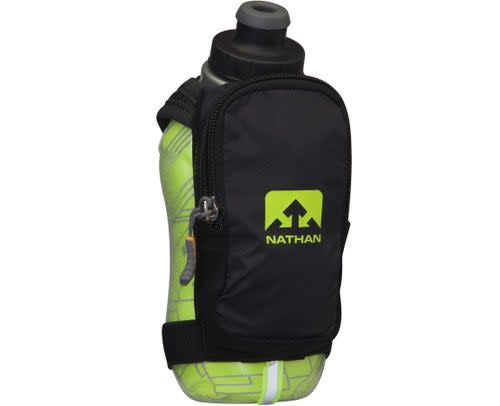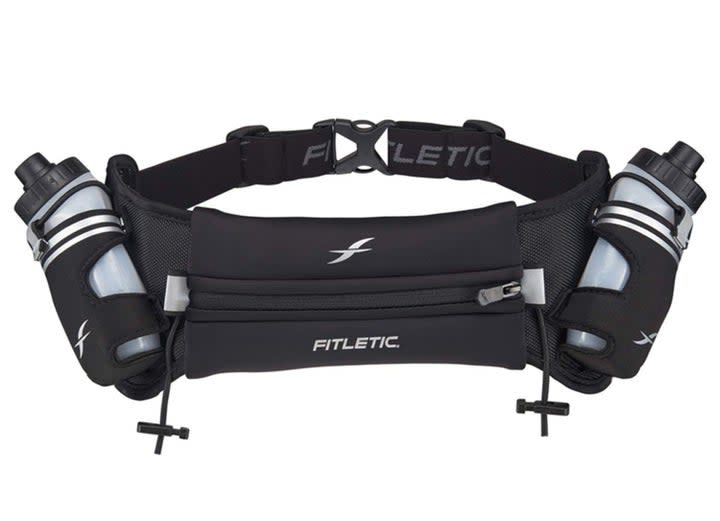Ask A Gear Guru: How Should I Carry Water While Running?
This article originally appeared on Triathlete
There's no way around it. On workouts lasting more than an hour, you should be drinking water. Though some runners stay hydrated by plotting a route with public water fountains along the way (or stashing bottles in the bushes along the route), most opt to stow their agua on their person during a run. And today, with public water sources being either questionable or sometime just shut down, it’s smarter than ever to carry your own.
The simplest and cheapest way to carry your water while running is by simply holding a water bottle in one hand, but sweat and large bottles can make it hard to get a good grip, distracting you from more important things like form and pace. Luckily, multiple options exist for runners to carry hydration in practical and convenient ways.
RELATED: Are You Doing Thirst Right? The Science Says Probably Not
Carry Water While Running With A…Handheld Bottle

Nathan SpeedShot Plus Insulated Water Bottle
Nathansports.com, $27
For shorter runs, a handheld bottle can do the trick. Rather than a round one that is tough to grip, many athlete handhelds are molded to fit the curve of the hand. A strap keeps the bottle secure, while an optional pocket allows a small spot to stash a car key or a gel.
Pros:
A step up from simply holding a bottle since the strap does the work of keeping the bottle to your hand.
Many bottles come in insulated versions, which is handy on hot days.
Little risk of chafing from hand strap.
Cons:
Can affect upper body movement while running, especially if one hand is unweighted with a bottle.
Sound and feel of sloshing can be distracting for some runners.
Smaller size may not be enough for runs over one hour.
Some valve styles leak while being jostled on runs.
Handheld Soft Flask

Osprey Duro/Dyna Handheld
Osprey.com, $35
Instead of a molded plastic bottle, the handheld soft flask uses a flexible polyurethane to contain fluids. As the runner sips from the bottle, the polyurethane compresses. Like its hard-molded cousin, this option comes with a strap to secure the flask to the hand as well as a small pocket.
Pros:
Compression eliminates sloshing present in hard-molded bottles.
When the bottle is empty, it can be rolled up and stashed in a pocket.
Equipped with bite valves, which do not leak.
Cons:
Flexible bottles are cumbersome to fill up, especially on the fly.
Smaller size (360mL) may not be enough for runs over one hour without refills.
Carry Water While Running With A…Waist Belt

Fitletic Hydra 12 Hydration Belt
Amazon.com, $42
Waist belts come equipped with holsters to carry bottles. Some are located on the lower back to carry a single, larger bottle, while others hold multiple smaller bottles (often the same ones used in handheld hydration setups) around the waist.
Pros:
Hands are free to swing.
Can be adjusted to fit individual body type.
More capacity than handheld bottles.
In setups with multiple bottles, runner can carry multiple hydration options (one bottle with water, one with electrolyte beverage).
Most waist belts come with pockets large enough for gels, keys, ID and cell phone.
Cons:
Can bounce while running, causing distraction, discomfort and/or chafing.
If belt is too low, it can interfere with hip movements.
Sound and feel of sloshing can be distracting for some runners.
Retrieving and returning water bottles while running can be cumbersome.
Backpack

Osprey Duro/Dyna 15
Osprey.com, $165
For very long runs, especially those without easy access to water sources, a hydration backpack is an excellent option. These packs come equipped with a water bladder made of flexible polyurethane that can carry one to three liters of water--the Duro 15 comes with a 2.5-liter bladder.
Pros:
Distributes the weight across the surface of your back, allowing you to carry more water.
A hose with a bite valve makes this option the simplest one to use - no fumbling with bottles.
Large water capacity means no need to refill on most runs.
Multiple pockets to stash snacks, trail maps and other essentials.
Cons:
Water bladders can be difficult to clean.
Only one vessel limits options more than waist belt.
Multiple contact points increase potential for chafing.
Not all backpacks are built to fit the female physique, causing discomfort on the chest.
Carry Water While Running With A…Vest

Camelbak Zephyr Vest
Camlebak.com, $150
Like a backpack, a hydration vest allows a runner to carry more water than a handheld. However, a vest is more likely to carry the weight on the front of the body, in soft flasks held on the chest (though some vests use a water bladder on the back, like a backpack).
Pros:
Weight of is evenly distributed on front and back.
Runner can carry multiple hydration options (one bottle with water, one with electrolyte beverage).
Multiple pockets to stash snacks, trail maps, and other essentials.
Easier to adjust to individual body than a backpack.
Bottles are easier to wash than a hydration bladder.
Cons:
Cannot carry as much water as most hydration backpacks.
Retrieving and returning bottle while running can be cumbersome.
For exclusive access to all of our fitness, gear, adventure, and travel stories, plus discounts on trips, events, and gear, sign up for Outside+ today.

